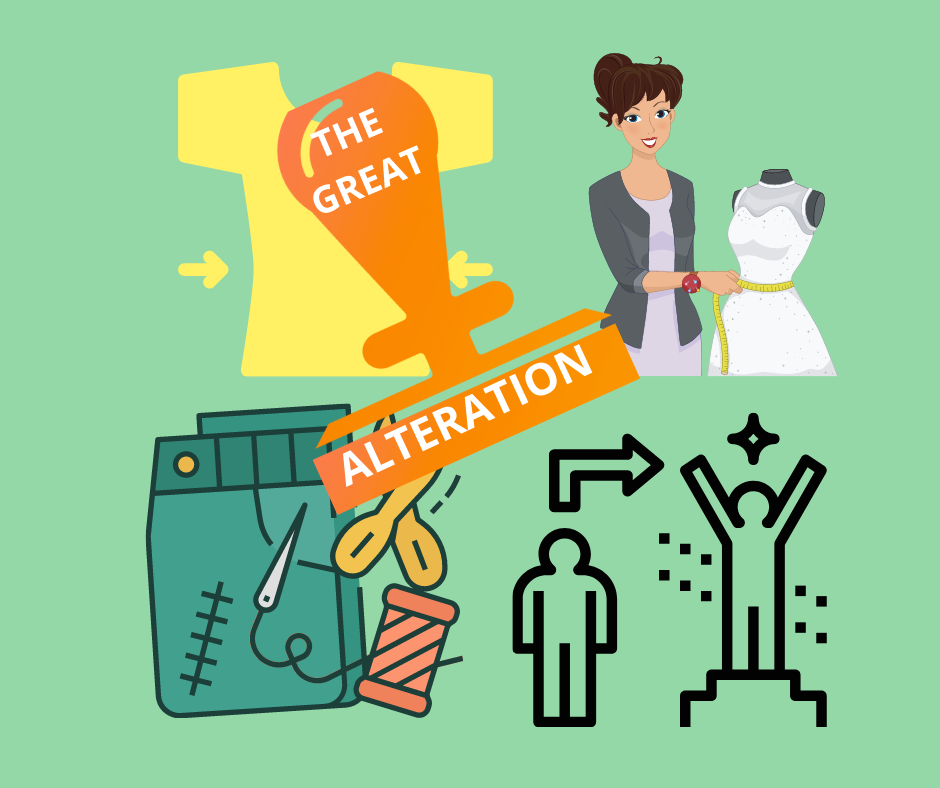“The great resignation also now being called the great transition (fast company.com) has some great insight as to what employees are looking for and employers need to do.”
res·ig·na·tion| ˌrezəɡˈnāSH(ə)n | noun 1 an act of retiring or giving up a position: he announced his resignation. 2 the acceptance of something undesirable but inevitable: a shrug of resignation.
tran·si·tion| tranˈziSH(ə)n, tranˈsiSH(ə)n | noun the process or a period of changing from one state or condition to another: students in transition from one program to another | a transition to multiparty democracy
al·ter·a·tion| ˌôltəˈrāSH(ə)n | noun the action or process of altering or being altered: alterations had to be made
al·ter| ˈôltər | verb change or cause to change in character or composition, typically in a comparatively small but significant way:
I’m renaming this movement “the great alteration.” When I alter a skirt, it is because I have outgrown it in some way. It needs to be changed – adjusted, remodeled, rearranged, restyled; tweaked to fit me. I could go on and on and on. Companies began their great alteration years ago by trimming down excess expenses, altering job descriptions, eliminating positions, and adding more responsibility to those positions that remained. It is about time the workforce begins to alter the workplace parameters to meet 21st century needs. The workforce isn’t transitioning, it is altering the way we work.
There is no great resignation or transition for the newest generation of workers. 10 years ago companies started changing the way they treated their employees. The new workforce never experienced what was traditional or transitional. For example, when I started work over 30 years ago I was told I’d have benefits – a pension, pay raises, vacation, and sick time.
Over 10 years ago, my company froze the pension, started making us pay for healthcare, reduced our vacation time and sick time accrual, added to our workload, reduced staffing… and it goes on and on with each new contract. Once upon a time, in the United States, a company took care of their employees. I believe it was part of the American Dream. Now it is a transaction. Today our new talent is signing up for a job expecting to spend only 2 to 3 years with a company before moving on. They know there is no pension or golden handshake at the end of their career, so instead they make adjustments or move onto other more fulfilling, more challenging, and probably more financially lucrative opportunities.
Recently, we’ve seen the introduction of a new type of workforce – the “gig workers” (e.g., Uber, Fiverr, and contract workers). In this environment, gig workers may take two or three different part-time jobs to create a schedule that works for them. Why do it? Flexibility and hours, the time(s) and day(s) they can work, and whether they can work from home or remotely because of personal responsibilities or a lifestyle. It’s convenient for both workers and the employers. It gives workers the ability and freedom to make their own schedules and work as much or as little as they want and relieves the “buyer” of paying for workers compensation.
Today, our new workforce puts emphasis on things like flexibility, remote working, a company’s values, and benefits. By the way – benefits are not just health insurance and sick time anymore. It’s personal days, maternal/paternal/family leaves, and not being punished for taking a day off because your child is celebrating an important event. It’s also recognizing a need to address mental health as a legitimate reason to take time off and valuing inclusivity of others’ needs.
This is not saying that all companies and work fields will be remote or have a rapid turnover in help. There will always be a need to keep top caliber workers in a company. For these positions, salaries, “traditional” benefits, and perks will be negotiated to include cost-of-living raises and workplace quality. But with the growing gig economy, and accessibility to information everywhere, workplaces will have to begin to offer amenities that entice a worker to come into the office. They will need to recognize the time it takes to commute to work, especially now that travel time has increased with population growth. Traditional work spaces are transforming to provide greater ease for work/life balance for employees. Kitchen areas with snacks and beverage bars, dry cleaning services, day care, quiet rooms, and scheduling hybrid work locations are starting to become more prevalent.
Who knows exactly what our new altered workplace and positions will look like in 5 or 10 years from now? As a career coach, I advise my clients to find a career pathway and/or job that first aligns with your personality, and strengths. Second, I ask them to identify an environment where they can be productive, feel comfortable and safe in the space, accommodate the commute time, and enjoy company culture. Then a work/life balance needs to be addressed. These are the activities that address personal and professional needs, family, and skills. Work is the second largest activity in our lifetime – doesn’t it make sense to be at the right job and be appreciated for it?
